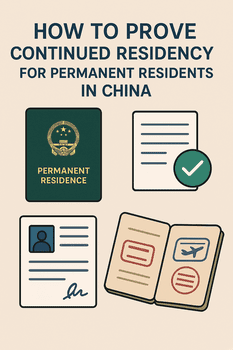
For expatriates holding China Permanent Residence (Green Card), maintaining valid residency status requires careful attention to specific requirements and documentation.
Since the 2023-2024 immigration reforms and the introduction of the Five-Star Card system, China has modernized its residency verification processes while maintaining strict compliance standards.
This comprehensive guide outlines the exact requirements, documentation needs, regional variations, and digital verification methods to ensure your permanent residency remains in good standing.
Understanding Precise Residency Requirements in 2025
China’s National Immigration Administration (NIA) has established clear numerical thresholds for maintaining permanent residency status:
| Requirement Type | Standard Threshold | Special Categories Threshold | Verification Method |
|---|---|---|---|
| Minimum Annual Stay | 183 days per calendar year | 90 days for qualified investors/experts | Digital entry-exit records |
| Maximum Consecutive Absence | 180 days without special permission | 365 days with pre-approval for business/academic purposes | Border control system |
| Annual Reporting Window | January 1 – March 31 annually | Extended to June 30 for those abroad during standard window | Online or in-person verification |
| Document Retention Period | 5 years for all residency proof documents | 7 years for tax and property records | Random audit checks |
Source: National Immigration Administration Directive 2024-37
“The 183-day rule is strictly enforced through digital tracking systems. Permanent residents should carefully monitor their time outside China, as even a single day beyond the threshold can trigger a compliance review.”
— Wang Li, Immigration Attorney, Global Law Partners Shanghai
Regional Variations in Residency Requirements
Residency verification procedures and flexibility vary significantly across different regions of China:
| Region | Minimum Stay Variation | Digital Integration Level | Special Provisions | Local Authority |
|---|---|---|---|---|
| Shanghai | Standard (183 days) | Fully digital verification | Fast-track verification for high-talent individuals | Shanghai Public Security Bureau Exit-Entry Administration |
| Beijing | Standard (183 days) | Fully digital verification | Academic exceptions for university affiliates | Beijing Municipal Public Security Bureau |
| Greater Bay Area | Reduced to 150 days for qualified professionals | Fully digital with facial recognition | Cross-border mobility allowances for Hong Kong/Macau business | Guangdong Provincial Public Security Department |
| Hainan Free Trade Port | Reduced to 120 days for investors | Pilot blockchain verification system | Special provisions for medical tourism professionals | Hainan Provincial Immigration Bureau |
| Western Regions | Standard with flexibility for business developers | Hybrid digital/physical verification | Extended absence allowances for infrastructure projects | Local Public Security Bureaus |
Source: China Immigration Policy Regional Implementation Guide 2025
Comprehensive Documentation Requirements
1. Residence Registration and Five-Star Card Verification
The foundation of residency proof is proper registration:
- Initial Police Registration: Required within 24 hours of arrival at each new address
- Five-Star Card Activation: Digital verification through the Immigration Administration app
- Biometric Verification: Annual fingerprint and facial recognition update
- Address Change Notification: Must be completed within 10 days of any move
Source: National Immigration Administration: Five-Star Card Management Guidelines
2. Physical Presence Documentation
Multiple evidence types are needed to establish physical presence:
| Document Type | Minimum Frequency | Authentication Requirement | Digital Acceptance |
|---|---|---|---|
| Entry-Exit Records | Complete annual history | Automatically verified in NIA system | Available through Immigration app |
| Residence Registration Records | Each address change | Police-stamped registration form | Digital verification in tier-1 cities |
| Facial Recognition Check-ins | Quarterly in some regions | Automated through NIA app | Fully digital |
| Transportation Records | Supporting evidence only | Not required but helpful | Digital records accepted |
Source: China Immigration Lawyers Association: Residency Compliance Guide
3. Financial and Economic Presence
Demonstrating economic ties to China strengthens residency claims:
- Tax Payment Records: Annual individual income tax filings (complete Form 5 years)
- Social Security Contributions: Monthly payment records if employed
- Bank Statements: Showing regular transactions within China (minimum quarterly activity)
- Investment Records: For investor permanent residents, proof of maintained investment levels
“Tax compliance is perhaps the strongest evidence of continued residency. The tax bureau and immigration authorities have fully integrated systems as of 2024, allowing automatic verification of tax compliance status.”
— Dr. Zhang Wei, Tax Compliance Expert, China Tax Institute
4. Property and Utility Documentation
Housing-related documentation provides strong residency evidence:
| Document Type | Required Frequency | Name Requirement | Verification Method |
|---|---|---|---|
| Rental Contracts | Valid for entire period | Must be in PR holder’s name | Real estate bureau registration |
| Property Ownership | Current deed | Must be in PR holder’s name | Digital property registry |
| Utility Bills | At least quarterly | Name matching or family member | Random verification |
| Property Management Fees | Payment receipts | Address must match registration | Supporting evidence |
Source: Ministry of Housing and Urban-Rural Development Guidelines
5. Employment or Business Activity
Professional activities in China are crucial for residency verification:
- Employment Contracts: Valid work contract with a Chinese entity
- Salary Payment Records: Monthly deposits from Chinese employer
- Business License: For entrepreneurs, valid business registration
- Company Tax Contributions: Corporate tax filings for business owners
- Professional License: For certain professions (medical, legal, etc.)
The Mandatory Annual Reporting Requirement
Since 2023, all permanent residents must complete an annual reporting process:
Annual Reporting Timeline and Procedures
| Reporting Element | Deadline | Submission Method | Required Documentation |
|---|---|---|---|
| Online Pre-registration | January 1-31 | NIA website or app | Five-Star Card number, passport details |
| Documentation Submission | February 1-March 31 | Online or in-person | Proof of residence, financial activity, employment status |
| Biometric Verification | Within reporting window | In-person at PSB or through authorized app | Fingerprints, facial recognition |
| Final Confirmation | Provided immediately | Digital certificate | Stored in government database and personal app |
Source: National Immigration Administration Annual Reporting Guidelines 2025
“Missing the annual reporting deadline is the most common reason for permanent residency complications. The system now sends automated reminders, but ultimate responsibility remains with the card holder.”
— Chen Mei, Deputy Director, Shanghai Exit-Entry Administration Bureau
Special Circumstances and Exceptions
The 2024 immigration reforms introduced several important exceptions to standard residency requirements:
Authorized Exceptions to Residency Requirements
| Exception Category | Eligibility | Maximum Allowance | Application Procedure |
|---|---|---|---|
| Medical Treatment | Documented serious illness | Up to 365 days | Pre-approval with medical documentation |
| Academic Research | University/research affiliation | Up to 24 months | Academic institution sponsorship |
| Business Development | Company founders/executives | Up to 270 days annually | Business necessity documentation |
| Family Emergency | Immediate family emergency | Case-by-case basis | Emergency application process |
| Elderly Permanent Residents | Age 70+ | Reduced to 90 days annually | Automatic with age verification |
Source: National Immigration Administration Special Circumstances Directive
To apply for exceptions:
- Submit application through the NIA app or website
- Provide supporting documentation
- Receive digital approval before exceeding standard limits
- Maintain documentation of approval throughout the exception period
Digital Verification and Technology Integration
China has rapidly digitalized its immigration verification systems:
Digital Tools for Residency Verification
| Digital Platform | Primary Function | User Access Method | Implementation Status |
|---|---|---|---|
| Immigration Administration App | Comprehensive residency management | Five-Star Card login | Mandatory nationwide |
| Residence Verification Mini-Program | Quick verification checks | WeChat integration | Available in 31 provinces |
| Biometric Verification System | Identity confirmation | Authorized scanning locations | Mandatory for annual reporting |
| Blockchain Residency Record | Immutable residency history | Backend government system | Pilot in 7 major cities |
| Social Credit Integration | Compliance scoring | Automatic government tracking | Partial implementation |
Source: China Academy of Information and Communications Technology: Immigration Digitalization Report
Legal Consequences and Remediation
Understanding the specific consequences of non-compliance is essential:
| Compliance Issue | Consequence | Remediation Process | Processing Time |
|---|---|---|---|
| Failure to Meet Minimum Stay | Warning, potential review | Explanation letter, future compliance plan | 30-90 days |
| Missed Annual Reporting | Status suspension, ¥2,000 fine | Late reporting with penalty payment | 15-30 days |
| Extended Unauthorized Absence | Potential card revocation | Formal appeal with justification | 90-180 days |
| Incomplete Documentation | Compliance review | Document supplementation | 15-45 days |
| False Documentation | Card revocation, potential ban | Legal appeal only | 180+ days |
Source: China Immigration Law Enforcement Guidelines 2025
Practical Application Procedures
Where and How to Submit Residency Verification
| Verification Method | Appropriate For | Processing Time | Required Preparation |
|---|---|---|---|
| Online Submission | Routine verification, annual reporting | 5-15 working days | Digital documents, facial verification |
| In-Person at PSB | Complex cases, first-time verification | Same-day to 7 days | Original documents, appointment booking |
| Mobile Verification Units | Elderly, disabled, or remote residents | By appointment | Advance registration required |
| Authorized Service Centers | Premium service for business executives | 1-3 working days | Service fee applies |
Source: Public Security Bureau Exit-Entry Administration Service Guide
Appointment Booking Procedures
- Access the National Immigration Administration website or app
- Select “Residency Verification Appointment”
- Choose preferred location and time slot
- Receive QR code confirmation
- Bring all required documentation to appointment
Expert Recommendations for Foolproof Residency Maintenance
Based on interviews with immigration experts and official guidelines:
- Create a Digital Calendar: Track days outside China with automatic alerts at 150 days
- Maintain a Documentation Portfolio: Keep both digital and physical copies of all residency evidence
- Set Up Automatic Bill Payments: Ensure continuous utility records even during short absences
- Establish Banking Presence: Maintain regular financial activity through a Chinese bank account
- Register for Early Notifications: Opt into the NIA early warning system for compliance deadlines
- Conduct Self-Audits: Quarterly review of your residency documentation and day count
- Develop Relationships: Maintain contact with local police station and immigration officials
“The most successful permanent residents approach residency verification proactively rather than reactively. Creating systems to automatically generate and preserve evidence of your continued connection to China is far more effective than scrambling to gather documentation when questions arise.”
— Li Jing, Director, International Talent Services Center, Beijing
Conclusion
Maintaining valid permanent residency status in China requires understanding precise requirements, diligent documentation, and awareness of regional variations.
With the digitalization of China’s immigration systems, verification has become more streamlined but also more thorough.
By following the specific guidelines outlined in this comprehensive guide, permanent residents can ensure their status remains secure while enjoying the benefits of long-term residence in China.
For the most current information, always consult the National Immigration Administration website or speak with a qualified immigration attorney specializing in Chinese permanent residency.



